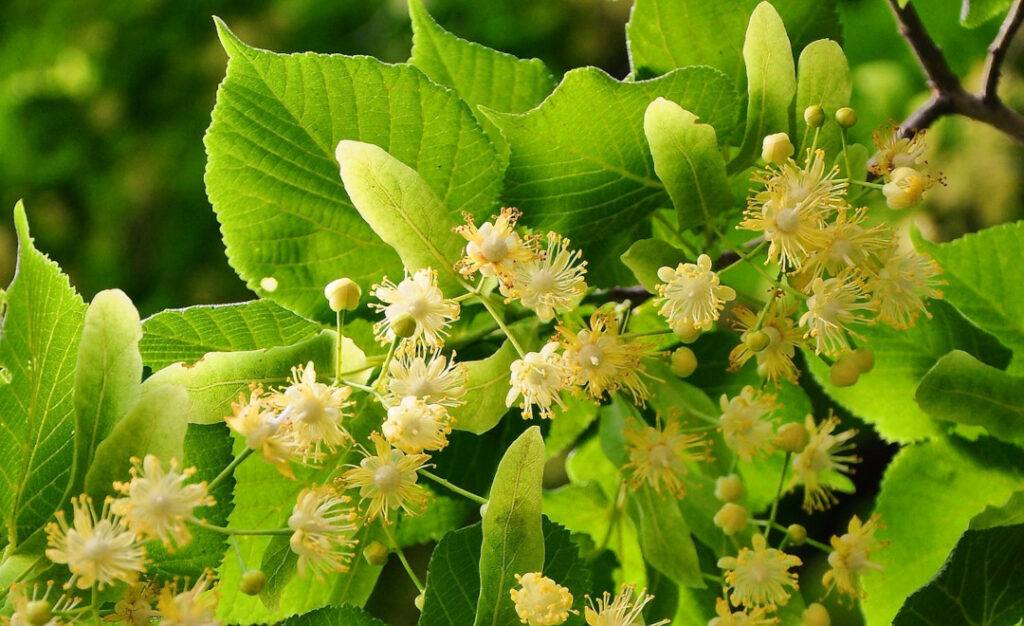
Poland
Linden (Lime) Tree
Tilia cordata

General Description/Cultural Significance
The Linden tree is woven deeply into the cultural identity of the Polish people. The word for July in Polish, lipiec, is derived from the word lipa, or lime-tree, and translates to “the time of year when the lime trees blossom.” These trees have been a beloved symbol for Polish poets, and was a notable muse for Jan Kochanowski, the 16th-century writer known as the father of Polish poetry. The wood of the Linden tree is used in traditional Polish wood carvings, its dried flowers are used for teas which alleviate stomach pain and insomnia, and according to folklore its scent is thought to dispel evil spirits.
Polish honey has a distinct flavor and scent due to its Linden origins as well. It has a floral and mint aroma along with components of geranium. Historically, linden honey is a widely used home remedy for colds, fevers, sore throats, and laryngitis. It is also effective in fighting liver and gallbladder problems. Externally, it can relieve pain and help treat eczema and burns on the skin. Linden flowers are very helpful for people who suffer from insomnia. As an essential oil it aids with sleep, and when consumed as tea it helps with minor nervous conditions. They have also been used to treat hypertension and provide relief for migraines.
Linden trees are such an ingrained part of Polish culture that parts of the tree (dried leaves, flowers, wooden carvings, etc.) are given as gifts to visitors and on special religious occasions. They are often planted outside of churches because of their association with the Virgin Mary, giving them a nearly holy status. It is even said that prayers spoken underneath Linden trees are more likely to be heard up above.
Climate Change/Conservation Status
Climate change has brought harsh weather conditions to Poland including eleven hurricanes since 2005 and bitterly cold winters. These changes are exacerbating existing pollution issues because Polish families have begun to burn coal and garbage in order to stay warm in the winter. According to the World Health Organization, 33 of the 50 most polluted cities in Europe are in Poland. Warsaw responded to this issue with a public policy making public transportation free when pollution rates are extremely high to encourage people to take the bus or subway instead of driving.
The Bialowieza Forest, which stretches from northeastern Poland into Belarus, is a United Nations World Heritage Site and contains some of the oldest deciduous and evergreen trees in Europe. It is also home to many rare plants which are extinct everywhere except within this forest. Unfortunately, the forest is facing many threats. Logging in the forest is restricted, yet the Polish government has continued illegal logging in the forest, effectively destroying the centuries-old thick undergrowth and historic trees. In 2018, the European Court of Justice ordered them to stop the illegal logging, but by that point there was a significant amount of damage already done. In addition to the man-made deforestation, 30% of the Spruce trees in the Bialowieza Forest have been destroyed by incredibly high rates of bark beetles.
The Linden tree in particular is vital for not only the culture of Poland, but also the survival of many of its other species. Linden trees provide food for the caterpillars of many types of moths including the lime hawk, peppered moth, vapourer moth, triangle moth and the scarce hook-tip moths. Also, they are very important for bees who drink their aphid honeydew from lime leaves. The dead wood of Linden trees is used by wood-boring beetles and by birds as nesting holes.
One aspect of the Linden tree, which is very annoying to many is that it is a common source of seasonal allergies. The intensity of these allergies though, is being worsened by climate change. Due to rising temperatures earlier in spring, the Linden trees have been flowering in May rather than their typical timeline of flowering in June. As a result, in 2018 the amount of pollen released by Linden trees was three times higher than it had been in the past 17 years. To return the Linden tree to its natural flowering schedule, a good deal of global cooperation is needed to prevent further temperature increases in the future.
Sources
Trust, W., 2022. [online] Lime, Small-Leaved, Woodland Trust.
Weryszko-Chmielewska, E., Piotrowska-Weryszko, K. and Dąbrowska, A., 2019. Response of Tilia sp. L.
to climate warming in urban conditions – Phenological and aerobiological studies. Urban Forestry & Urban Greening, 43, p.126369.

